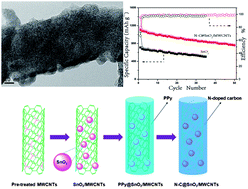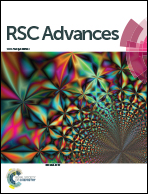A hybrid nanostructure encapsulating SnO2 nanoparticles as the anode material for lithium ion batteries with high electrochemical performance†‡
Abstract
A hybrid nanostructure, which consists of multi-walled carbon nanotubes (MWCNTs) and nitrogen-doped carbon encapsulating SnO2 nanoparticles is synthesised as the anode material for lithium ion batteries to improve the initial coulombic efficiency and cycle stability of the SnO2-based anodes. For the N–C@SnO2/MWCNTs composite, the initial coulombic efficiency is 80%, and the specific capacity is as high as 757.0 mA h g−1 after 50 cycles at a current density of 100 mA g−1. The enhanced performance can be ascribed to the unique hybrid nanostructure. Incorporating the merits of the MWCNTs and the N-doped carbon cannot only ensure an excellent electronic transport and supply a continuous interface for electrochemical reaction, but also accommodate the mechanical stress from repeated lithiation of SnO2. Meanwhile, because of the synergic effect of the carbon layer, which decreases the surface area of the composite, and the nitrogen heteroatoms doping into the carbon materials, which may make the reversible process of the Equation (SnO2 + 4Li+ + 4e− → Sn + 2Li2O) durable in subsequent battery operation, the initial coulombic efficiency of the SnO2-based anode is improved. This approach provides guidance to modify the initial coulombic efficiency and the cycling stability of other anode materials for lithium ion batteries.


 Please wait while we load your content...
Please wait while we load your content...